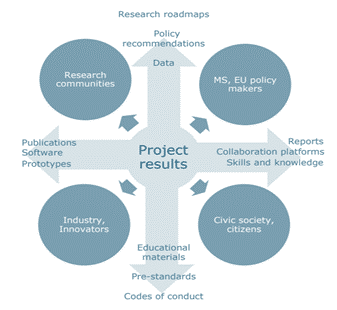In the dynamic energy landscape, the ongoing REEFLEX project offers a range of exploitable outcomes poised to redefine industry standards. These Exploitable Results (ERs) offer a spectrum of possibilities, from cutting-edge technologies to streamlined processes and interconnected networks, aimed at enhancing engagement with demand-side flexibility markets. In this article, we explore the diverse outcomes of REEFLEX, ranging from advanced analytics platforms to pioneering algorithms and market selection tools. Join us as we uncover how these innovations are reshaping the energy landscape and paving the way for a more agile and responsive future.

Leveraging REEFLEX Exploitable Results (ERs)
REEFLEX Exploitable Results (ERs) represent the outputs generated throughout the REEFLEX project that hold potential for utilisation and impact, whether by project partners or other stakeholders. These outcomes encompass various elements such as knowledge, technology, processes, and networks, which can contribute to future research or innovation endeavours. Furthermore, they may include tangible and exploitable products such as innovations, prototypes, and services.
Engaging in the exploitation of REEFLEX results entails evaluating how these outcomes can be integrated into the development, production, and promotion of a product or process, as well as in the enhancement and delivery of services.
The project’s objective is to develop new flexibility services that enhance the involvement of energy stakeholders in demand-side flexibility markets. In this context, REEFLEX will empower project partners to make significant strides in key Research and Innovation (R&I) lines and technologies, many of which are already exploitable or replicable in other sectors or applications by the project’s conclusion. It is crucial to support partners in crafting an optimal strategy to leverage the outcomes of the REEFLEX project effectively. To accomplish this goal, a comprehensive analysis of commercially viable outcomes within the project has been conducted.
A successful implementation and market penetration of REEFLEX outcomes require an effective exploitation plan with a suitable strategy. In this sense, understanding the unique characteristics of each outcome is crucial.
A Closer Look at Exploitable Results
A total of 15 ERs have been identified. Below, a brief description of REEFLEX Exploitable Results along with the expected Technological Readiness Level at the end of the project is provided:
1a. REEFLEX platform
The REEFLEX platform is designed as an interoperable big data platform that streamlines data collection, improves data quality, and incorporates AI services. Atop this platform, a package of services and a suite of interoperable self-contained modules will be deployed. Expected TRL at the end of the project: TRL 7
1b. REEFLEX Analytics Service
REEFLEX analytics platform collects, processes, and analyses data to facilitate informed decision-making. The REEFLEX Analytics Platform uses advanced technologies like machine learning and artificial intelligence to reveal hidden insights, forecast future trends, and automate decision-making processes. Expected TRL at the end of the project: TRL 7
2. VERIFY module/add-on
VERIFY is an additional platform that will be integrated within the overall REEFLEX platform. This web-based platform conducts environmental and cost-focused analyses and computations in accordance with ISO 14040 standards. It encompasses diverse features, including functionalities like Life Cycle Assessment (LCA), Life Cycle Cost (LCC), and real-time calculations of life cycle metrics. Additionally, the platform incorporates clustering techniques and economic analysis. Expected TRL at the end of the project: TRL 7
3. USE module/add-on
USE is an open-source web-based platform that facilitates the integration of diverse technical, environmental, economic, and social parameters, consolidating them into meaningful indices Expected TRL at the end of the project: TRL 7
4. Optimal microgrid management algorithms/add-ons
Optimal micro grid management algorithms oversee the functioning of various consumer types (such as residential, commercial, data centres, industrial facilities, and extensive electric vehicle (EV) charging points) imposed by optimal participation in flexibility markets and are projected to be executed both in the REEFLEX cloud, in proprietary clouds and on the edge. Expected TRL at the end of the project: TRL 5
5. Flexibility catalogue – 4
The flexibility catalogue relies on a tool that computes the Smart Readiness Indicator for grid and building assets. Simultaneously, it offers details about the manageability characteristics related to flexibility. Expected TRL at the end of the project: TRL 7
6. Smart flexible appliances – 5
The appliances will link to flexibility markets through sophisticated control solutions seamlessly integrated into the platform. Consequently, end-users will be able to receive suggestions and/or signals to implement both implicit and explicit demand response measures. Expected TRL at the end of the project: TRL 7-8

7. IoT with management capabilities – 6
REEFLEX implements a range of sensors, gateways, and concentrators, to collect and handle data within devices and transmit it to the platform. Algorithms for optimising grid management will be deployed at various levels, addressing diverse flexible resources, and operating in different environments. Expected TRL at the end of the project: TRL 7
8. Flexible V2G/batteries inverters
Innovative converters with improved efficiency and power density for a better conversion ratio in DC-based architectures. Their improved capabilities will facilitate more effective flexibility management and the delivery of additional energy services, including phase power balancing, as well as regulation of power factor and voltage. Expected TRL at the end of the project: TRL 7
9. Universal Battery Management
Utilizing second-life batteries, a strategy incorporating machine learning-driven algorithms will be integrated into the BMU. This strategy focuses on identifying operational parameters and conditions customised for specific use cases, facilitating the optimal integration and operation. Expected TRL at the end of the project: TRL 7
10. NILM disaggregation techniques
ML/DL algorithms enable the disaggregation of both residential (SEL) and industrial (CIRCE) energy loads. This enhances their capability to actively contribute to flexibility services. Expected TRL at the end of the project: TRL 6
11. Flexibility calculation and aggregation tools
Algorithms are developed to compute flexibility potential at the end-user level, strategies for aggregating these potentials, and requirements for providing flexibility at the grid/DSO level. Expected TRL at the end of the project: TRL 7
12. Market selection tool
Utilising the information gathered and processed by the REEFLEX platform, the market selection tool will be responsible for forecasting market behaviour and making optimal decisions regarding energy utilisation and flexibility market bidding. Expected TRL at the end of the project: TRL 7
13. P2P system
A blockchain platform facilitates direct interaction between two parties without the need for intermediaries. The process will be automated through the generation of Smart Contracts. Expected TRL at the end of the project: TRL 6
14. Common market module
The common operating market module at local, national and EU level will empower the establishment of requirements and standards for negotiating flexibility across various regions and among different entities within the trading system. Expected TRL at the end of the project: TRL 7